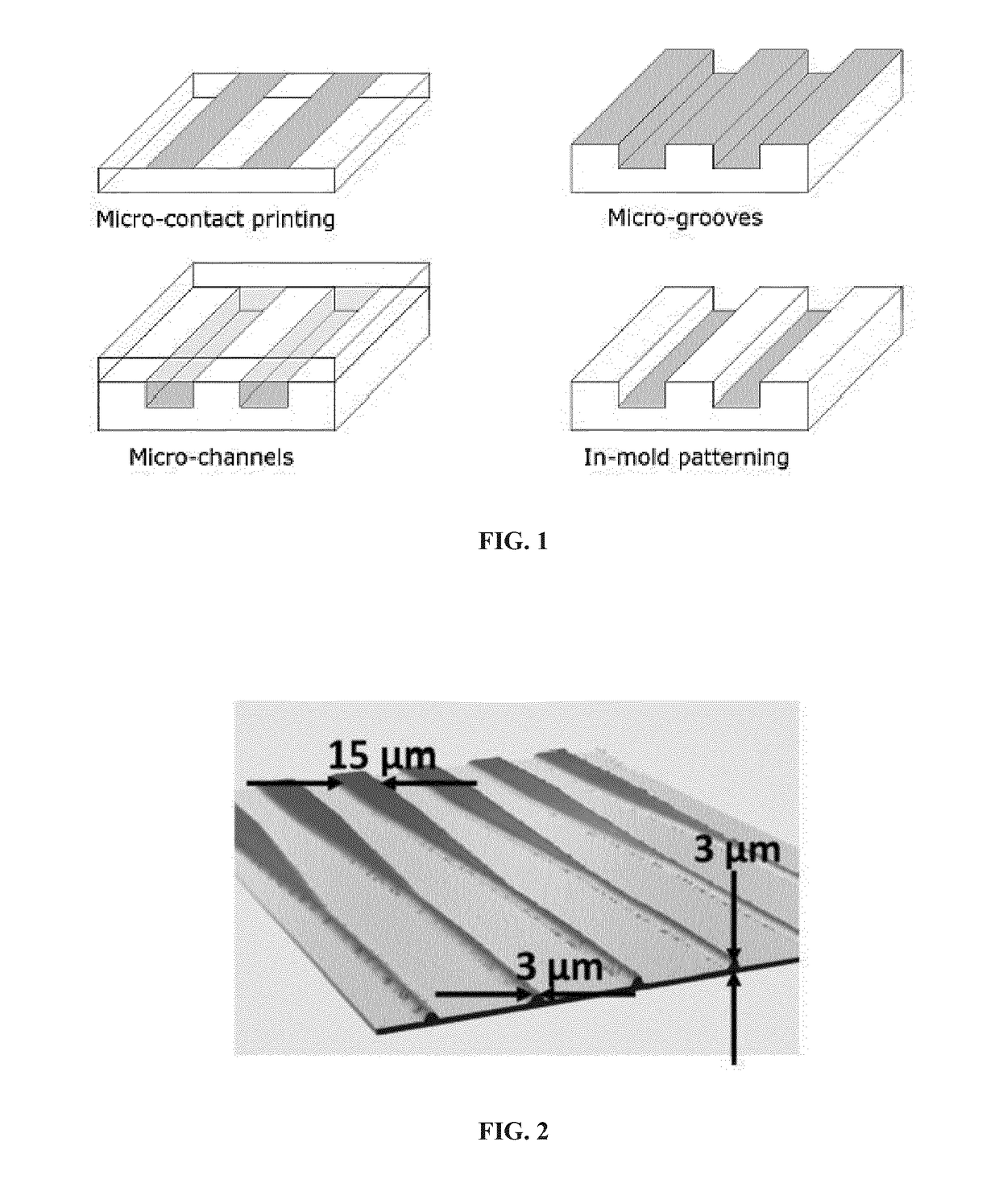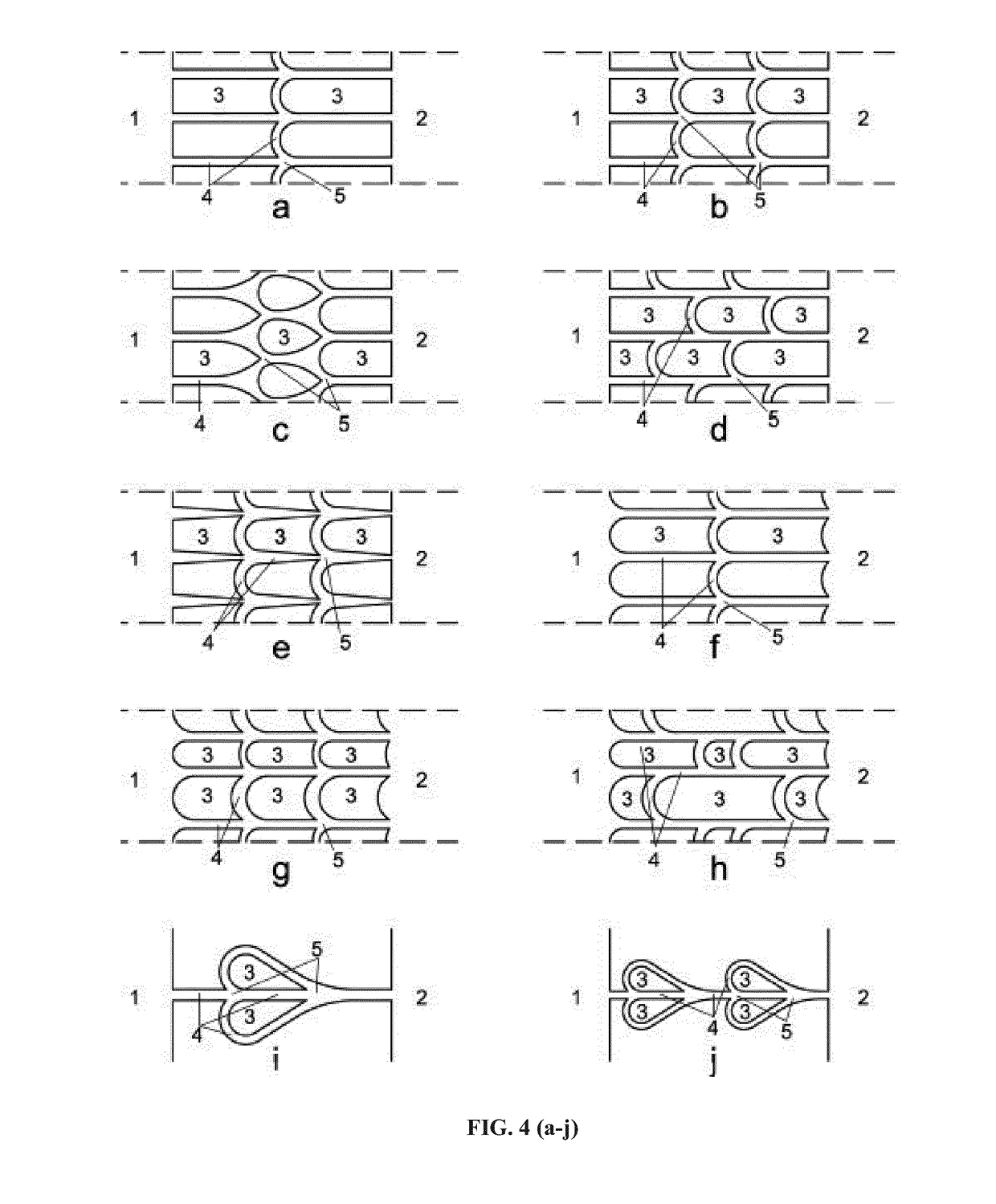Microfluidic Device for Controlling the Geometry of Living Bodies
a microfluidic device and living body technology, applied in the field of microfluidic devices and processes, can solve the problems of difficult to keep knowledge of the physical connectivity of individual neurons, difficult to experiment at the cellular level, and in a dense 3d array
- Summary
- Abstract
- Description
- Claims
- Application Information
AI Technical Summary
Benefits of technology
Problems solved by technology
Method used
Image
Examples
example 1
[0227]Examples of different types of guiding cues, as shown in FIG. 1, and of methods of prior art for the preparation of guiding patterns of the of the chemical type (surface treatment), of the physical type (microgrooves, microchannels), or of a type combining physical and chemical guiding cues (in mold patterning). The grey surfaces are FIG. 1 represent accessible areas while the white surfaces are inaccessible / repellent areas.
[0228]Creation of surface based guiding patterns (FIG. 1a) can be performed e.g. by microcontact printing, as in Offenhäusser A, et al. Soft Matter. 2007; 3:290-8. Microgrooves or microchannels (FIG. 1b, 1c) can be prepared e.g. by conventional techniques of soft lithography, by molding a polymer such as silicone (PDMS) upon a master, as described e.g. in Park J, et al. J Neurosci Methods. 2014; 221:166-74. The hybrid in mold patterning technique (FIG. 1d), finally, can be performed as described e.g. in Zhang J, et al. Biomaterials. 2006; 27:5734-9.
example 2
[0229]Example of designs of guiding patterns of prior art.
[0230]The guiding patterns presented in the following examples can refer indifferently to different patterning methods of prior art, as presented in FIG. 1, including guiding patterns of chemical nature (surface treatment), physical nature (microgrooves, microchannels), or of a combination of physical and chemical guiding cues (in-mold patterning). Various designs were presented e.g. in WO 2010040920 to Peyrin (FIG. 2A). among those, funnel shaped microchannels, such as represented in FIG. 2B, were used to produce directional filtering of axonal growth, using the higher probability of entry of the cell bodies (in particular, axons) into the wider entrance (here 15 μm wide) compared to the one for the narrower entrance (only 3 μm wide). However, making such tapered channels requires high resolution, hence costly microfabrication means, and the narrowing of the tracks in some embodiments can have harmful effects on axons or oth...
example 3
[0231]Examples of designs of devices of the invention.
[0232]In the devices of the present invention, in contrast, selectivity can be obtained without any channel narrowing, avoiding the above disadvantages. FIG. 3A demonstrates a surprising property of axons, here evidenced by immunostaining of beta-tubulin, to follow preferentially the edges of guiding patterns provided these edges deviate away from the growth direction at a rate low enough. In particular, axons can follow the edges of structures even along cusps with angles smaller than 180° up to a certain critical angle (here between 154° and 96°). FIG. 3B shows an example of guiding patterns exploiting the edge affinity of axons to produce directional connectivity between neurons, from the emitting chamber to the receiving chamber, and the typical behavior of axons is such guiding patterns. Depending on whether they are growing from the emitting chamber or the receiving chamber, these axons behave differently at the interconnec...
PUM
| Property | Measurement | Unit |
|---|---|---|
| radius of gyration | aaaaa | aaaaa |
| radius of gyration | aaaaa | aaaaa |
| radius of gyration | aaaaa | aaaaa |
Abstract
Description
Claims
Application Information
 Login to View More
Login to View More - R&D
- Intellectual Property
- Life Sciences
- Materials
- Tech Scout
- Unparalleled Data Quality
- Higher Quality Content
- 60% Fewer Hallucinations
Browse by: Latest US Patents, China's latest patents, Technical Efficacy Thesaurus, Application Domain, Technology Topic, Popular Technical Reports.
© 2025 PatSnap. All rights reserved.Legal|Privacy policy|Modern Slavery Act Transparency Statement|Sitemap|About US| Contact US: help@patsnap.com



